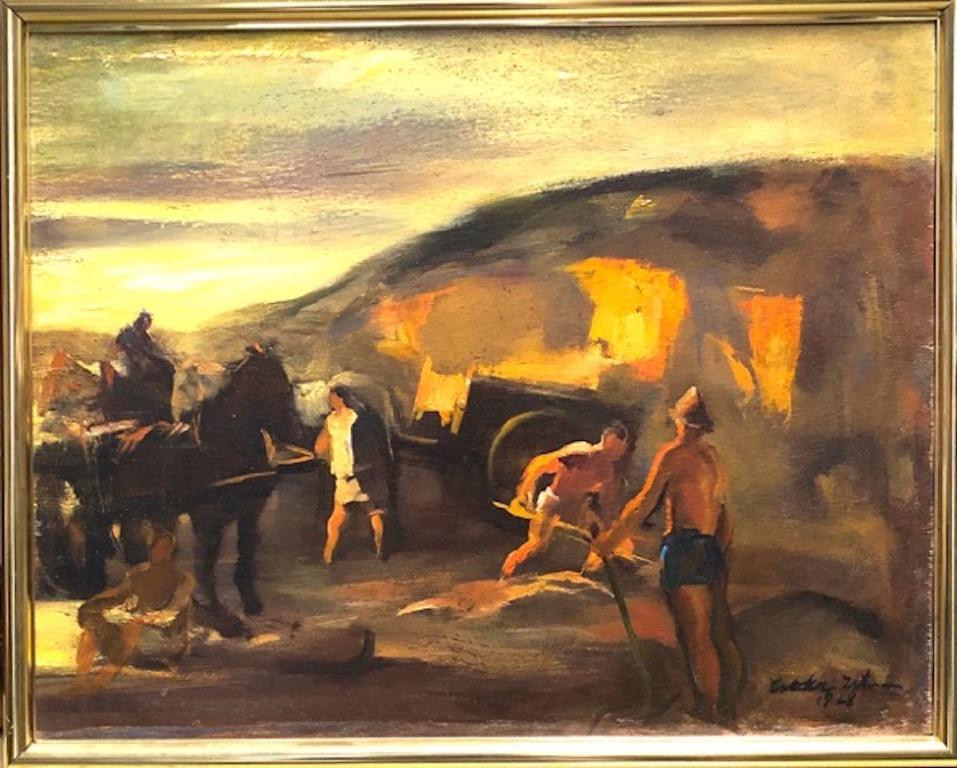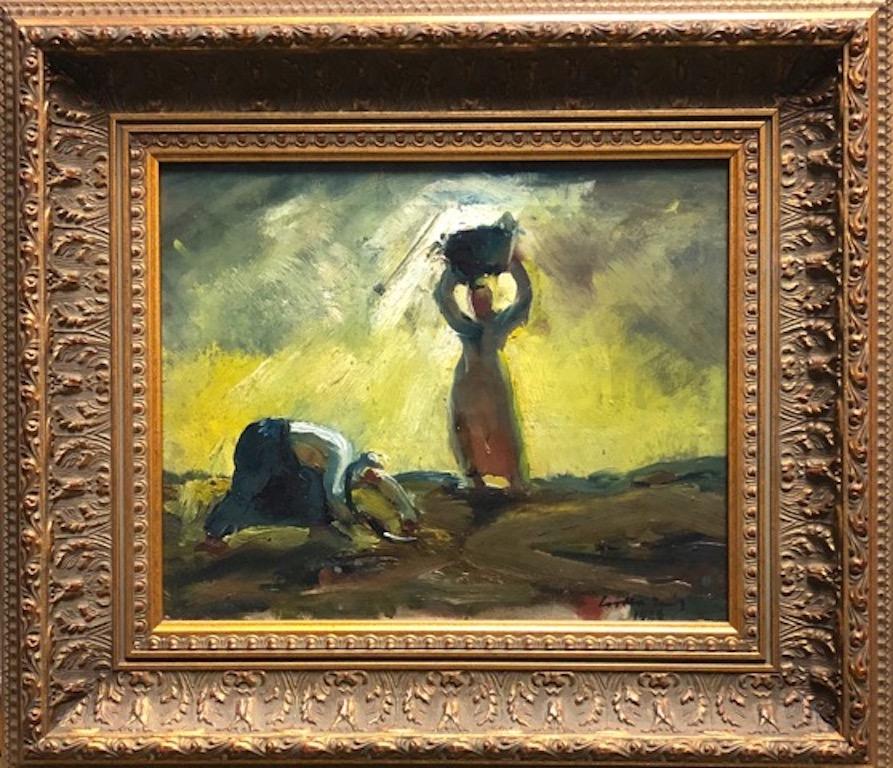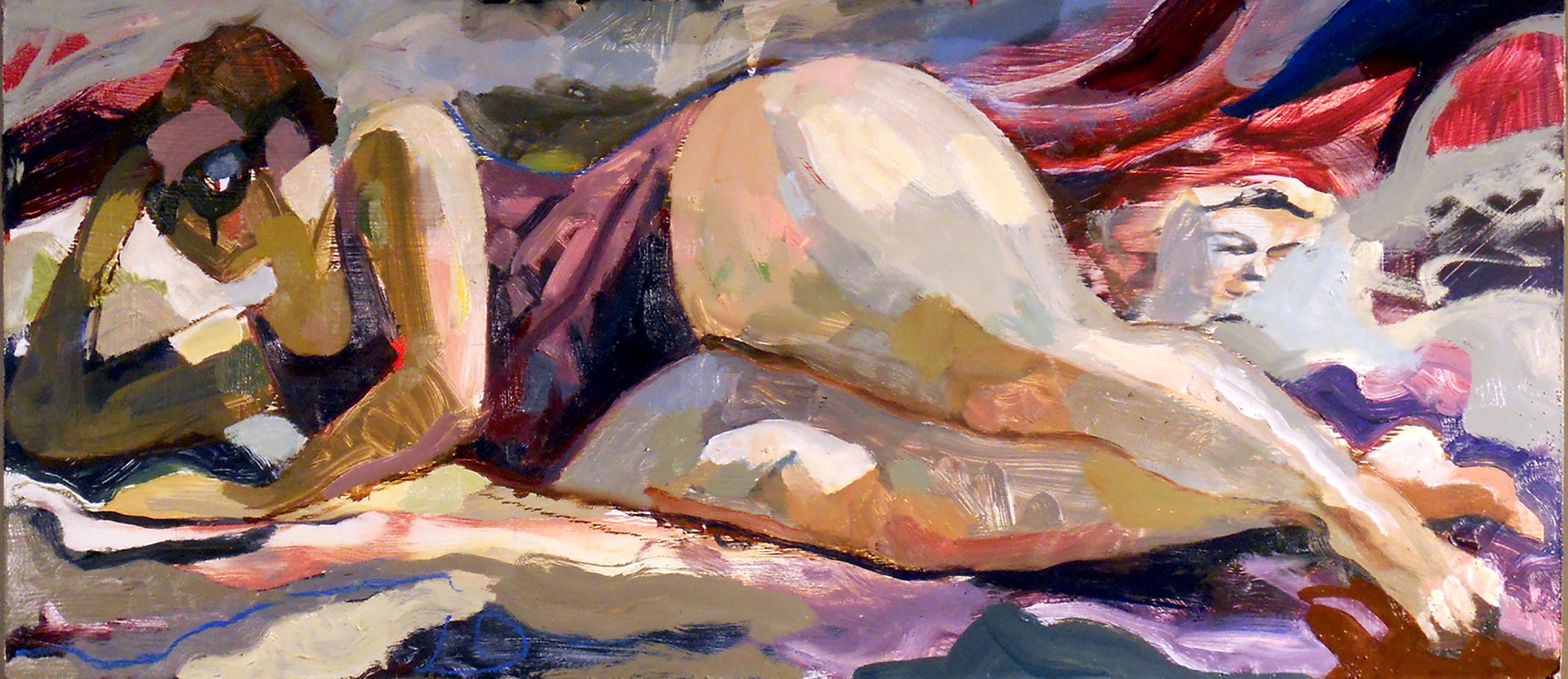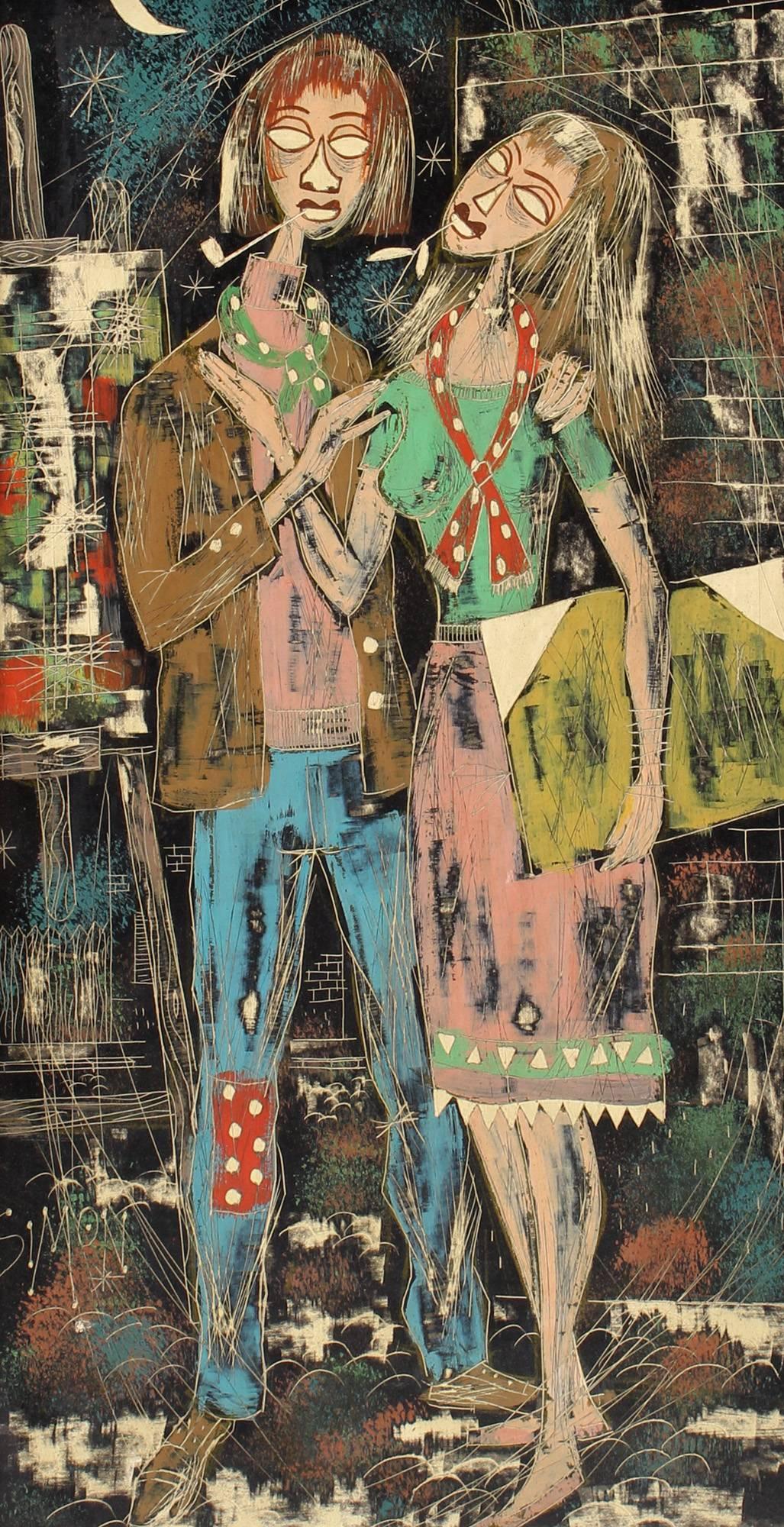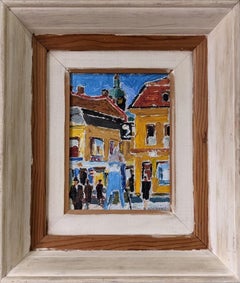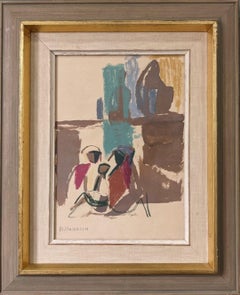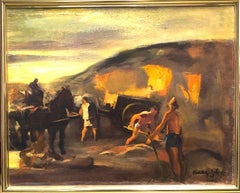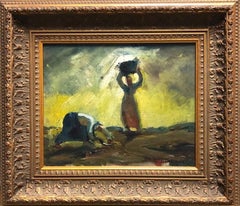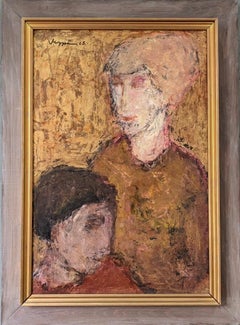
1965 Vintage Swedish Framed Figurative Portrait Oil Painting - Tender
View Similar Items
Want more images or videos?
Request additional images or videos from the seller
1 of 12
Unknown1965 Vintage Swedish Framed Figurative Portrait Oil Painting - Tender1965
1965
About the Item
- Creation Year:1965
- Dimensions:Height: 26.78 in (68 cm)Width: 19.69 in (50 cm)
- Medium:
- Movement & Style:
- Period:
- Condition:This oil on board is housed in a light wooden frame with gilt detail. The painting and frame are both in excellent vintage condition.
- Gallery Location:Bristol, GB
- Reference Number:1stDibs: LU1869212042872
About the Seller
5.0
Platinum Seller
These expertly vetted sellers are 1stDibs' most experienced sellers and are rated highest by our customers.
Established in 2020
1stDibs seller since 2022
74 sales on 1stDibs
Typical response time: 3 hours
More From This SellerView All
- Mid-Century Modern Swedish Oil Painting, Framed Street Scene - PedestriansLocated in Bristol, GBPEDESTRIANS Size: 35 x 30 cm (including frame) Oil on board A small yet very impactful modernist street scene composition, executed in oil onto board. This composition presents a b...Category
1950s Expressionist Figurative Paintings
MaterialsOil, Board
- Vintage Mid-Century Swedish Framed Figurative Oil Painting - The EnsembleLocated in Bristol, GBTHE ENSEMBLE Size: 29 x 37 cm (including frame) Oil on Canvas A small yet very striking mid century figurative composition, executed in oil onto canvas. The artist has used the exp...Category
1950s Expressionist Figurative Paintings
MaterialsCanvas, Oil
- Vintage Mid-Century Modern Swedish Framed Figurative Painting - Seated FiguresLocated in Bristol, GBSEATED FIGURES Size: 47 x 38 cm (including frame) Watercolour and pastel on paper An outstanding mid-century figurative composition, executed in pastel and watercolour on paper. Pa...Category
1950s Expressionist Figurative Paintings
MaterialsOil Pastel, Watercolor
- Vintage Mid-Century Modern Figurative Portrait Framed Oil Painting - LoneLocated in Bristol, GBLONE Oil on Board Size: 52 x 44.5 cm (including frame) A very well done mid-century modernist portrait composition, executed in oil onto board. A single seated figure sits alone, l...Category
1950s Modern Figurative Paintings
MaterialsBoard, Oil
- Vintage Mid-Century Modern Swedish Figurative Framed Oil Painting - The ChildrenLocated in Bristol, GBTHE CHILDREN Size: 36.5 x 66 cm (including frame) Oil on board A richly textured and endearing mid century modernist style figurative portrait, painted in oil onto board. Rendered ...Category
1950s Modern Figurative Paintings
MaterialsOil, Board
- 1965 Mid-Century Modern Swedish Framed Abstract Oil Painting - ConnectionLocated in Bristol, GBCONNECTION Size: 26 x 47 cm (including frame) Oil on board A brilliantly executed and beautifully textured abstract figurative oil composition, painted in 1965 by the established Sw...Category
1960s Modern Abstract Paintings
MaterialsOil, Board
You May Also Like
- Nandor Vagh Weinmann, Oil on cardboard, Naked Back, 1930sLocated in Saint Amans des cots, FROil on cardboard by Nandor VAGH WEINMANN (1897-1978), France, 1930s. Naked back. With frame: 64x56 cm - 25.2x22 inches ; without frame: 46x38cm - 18.1x15 inches. 8F format. Signed "Nandor V. Weinmann" lower left. In its Montparnasse frame. Very good condition. Born October 3, 1897 in Budapest, Nándor is the older brother of Elemer and Maurice Vagh-Weinmann. He came to Paris to present his work in 1931. He died on December 12, 1978 near Montereau (Seine-et-Marne) following an automobile accident. He is the most colorful of the three “expressionist” brothers. Painter of figures, landscapes, especially open mountains, and bouquets in bright colors. He is also a religious painter and then finds the tragic condition. Born in BUDAPEST on October 3, 1897, Nandor Vagh Weinmann belongs to a profoundly artistic people. Living in the heart of Central Europe where they came from Asia a millennium ago, the Hungarians have preserved a strong ethnic individuality whose mark is their very synthetic, non-Indo-European language. Resistant to secular invasions, they have kept the virtues of a very ancient humanity that have become rare in our modern world, especially since their way of life has remained essentially rural until today. In the arts they know how to express a generous, extreme sensibility and by the poetic verb, by the musical rhythms and also by a popular art of a richness, an exceptional harmony. Until the age of thirty-four, during the decisive years of childhood and youth, Nandor Vagh Weinmann was intimately imbued with popular life and the soul of Hungary. From the capital where his father was a jeweler and had a family of ten children, Nandor was the fifth, he knew first of all the suburbs, the populated districts, the rigors in winter of the cold and the snow. A very mobile existence made him acquainted with all of Hungary, from the Danube to Transylvania, its infinite plains and its wild mountains, its immense villages with ample low houses, and its towns which are still immense villages. The painter is passionate about rustic works, harvest scenes, beautiful folk costumes. Coming into direct contact with the peasants, he learned to know their soul. These contacts gave the artist a direct feeling for popular life and soul, as Millet once understood the peasants of Barbizon and Normandy whose existence he shared. What fascinated Nandor Vagh Weinmann above all were the festivals which enlivened the dreary life of the countryside, the circuses, the merry-go-rounds, the gypsies unleashing orgies of music, light and color. In the party, and especially the Hungarian party, the whole soul of a people, all its energy, its need for movement, for intensity, is expressed in its pure state and realizes the primary and essential form of what is called beauty. And as if melted at the party, there is the infinite steppe where herds of horses and oxen circulate where terrible storms sometimes roar where the seasons unfold their grandiose splendours. The young Nandor Vagh Weinmann nourishes his sensitivity to his inexhaustible shows, both eternal and always new, a sensitivity which very early declared itself that of a painter. Since the age of fourteen he painted, and since then he never stopped doing it. Two of his brothers Maurice, two years his junior, who had a remarkable career similar to that of Nandor and later Elemer who became Maurice's pupil, also devoted themselves to painting, despite family obstacles. And the three brothers united by a common passion worked together in Hungary and later in France. Painting was so much in the blood of the family, as in the past among the Veroneses, the Breughels, the Lenains, the Van Loos and so many other artistic dynasties, that three sons of the Vagh Weinmanns became painters in their turn. One of these, Emeric, son of Nandor, today occupies an important place in the contemporary school. Nandor, at fifteen, was a pupil of the Academy of Fine Arts in Budapest where he worked diligently, then at that of Vienna. He painted many portraits, but also landscapes, compositions and, by his relentless work, managed to live from his brush, although married very young and having to overcome many hardships. He therefore knew the hardships and miseries of life. These strongly impregnated his vision as an artist and explain the thrill of humanity that runs through all his work. A particularly moving experience was reserved for him at the age of twenty. In the hospitals of Budapest he had to paint extraordinary cases, operations, frightful wounds, the deformations to which our poor body is subjected by traumas and physiological decompositions. In these circumstances, it is not a question of gratuitous art, of formal research but of immediate, authentic expressions of our flesh and our being. We know that Breughel Velázquez and Goya had been haunted by the sight of cripples and of madmen Géricault by that of corpses. But life is ultimately stronger than anything, and it is life that Nandor Vagh Weinmann has passionately observed and translated through all the places where he has always painted on nature. Nothing stopped him. It happened to him to paint, for example in front of the mill of Linselles by a weather so cold, that nobody could stay outside, and that he did not leave the place before having finished his work. Because he works constantly on the ground, under the sky, in the silence he loves. His reputation is established. He exhibited at the national fair in Budapest, in the big cities of Hungary Szeged, Szombathely, Veszprém, Kaposvar. In 1931, like all artists in the world, he came to France. But unlike the others, he did not settle in Paris. Because Nandor Vagh Weinmann does not belong to this group of cosmopolitans that we call the School of Paris. He settled in Toulouse, where he remained for a long time with his brothers, and traveled throughout France, eager for new ties, exhibiting in the most diverse cities, in Bordeaux, Marseille, Lyon, Agen, Bayonne, Dax, Tarbes, Grenoble, Nice, Cannes, Strasbourg, Mulhouse, Colmar, Lille. He even crossed borders. He was in Saint Sebastian, in Geneva, and once in Egypt in 1927 where he painted King Fouad...Category
1930s Expressionist Figurative Paintings
MaterialsOil, Cardboard
- Sand Pit Hungarian American Painting Workers Horses European Modernism 1928 WPABy Stephen CsokaLocated in New York, NYSand Pit Hungarian American Oil Painting Workers Horses European Modernism 1928 WPA The board measure 10 3/4 x 15 1/2 inches. The work was painted in Hunga...Category
1920s Expressionist Landscape Paintings
MaterialsOil, Board
- "Harvest" Working Women Hungarian European Modernism Expressionism 1926 WPA EraBy Stephen CsokaLocated in New York, NY"Harvest" Working Women Hungarian European Modernism Expressionism 1926 WPA Era. 10 x 11 inches oil on board. Painted in Hungary. Stephen (Istvan) Csoka was born in Gárdony, Hungary on January 2, 1897 and died in New York in 1989. He is best remembered as a painter and etcher of portraits, nudes, landscapes, genre, and horses. Csoka studied at the Budapest Royal Academy of Art and his memberships include Associate of the National Academy of Design in New York City; the Society of American Etchers in Brooklyn, NY; the Society of Brooklyn Artists; and the Hungarian Etchers Association. Csoka's exhibitions and awards include a medal at the Barcelona International Exhibition in 1929; a prize at the City of Budapest Exhibit in 1930; prizes at the Society of American Etchers in 1942 and 1945; prizes at the Library of Congress in 1944 and 1946; a prize at the Society of Brooklyn Artists in 1944; a prize at the Philadelphia Watercolor Club in 1945; the Corcoran Gallery of Art in 1945; the Carnegie Institute in 1943, 1944, and 1945; the Art Institute of Chicago in 1944; the Los Angeles Museum of Art in 1945; the National Academy of Design from 1940 through 1945; one-artist shows at the Contemporary Artists in 1940, 1943, and 1945; and the Minneapolis State Fair in 1943. *Stephen continued to recieve awards and exhibit his work throughout his life. In 1997, Hofstra Museum sponsored a Retrospective/Centennial exhibition in honor of his birth. Collections representing Csoka's work are the Metropolitan Museum of Art, New York, NY; the Brooklyn Museum, Brooklyn, NY; the Museum of Fine Arts, Boston, MA; the British Museum, London, England; the Bezalel National Museum, Jerusalem, Israel; the Butler Institute of American Art, Youngstown, Ohio; Whistler House Museum of Art, Lowell, MA; the Cleveland Museum of Art, Cleveland, OH; Columbus Museum of Art, Columbus, OH; the Sheldon Swope Art Museum, Terre Haute, IN; the Mobile Museum of Art, Mobile, AL; the Frederick R. Weisman Art Museum, Minneapolis, MN; the Museum of New Mexico, Santa Fe, NM; the Budapest Museum of Fine Arts, Budapest, Hungary; Hungarian National Gallery, Budapest, Hungary, the Museum of the City of Budapest, Budapest, Hungary; the Library of Congress, Washington, DC; Carnegie Museums of Pittsburgh, Pittsburgh, PA; the Chrysler Museum of Art, Norfolk, VA; Georgia Museum of Art, Athens, GA; Hofstra Museum, Hofstra University, Hempstead, NY; Holocaust Museum, Glen Cove, NY; National Academy of Art, New York, NY; New Orleans Museum of Art, New Orleans, LA; New York Historical Society, New York, NY;New York Public Library, New York, NY; National Gallery of Art, Washington, DC; Peabody Museum, Cambridge, MA; Pennsylvania Academy of the Fine Arts, Philadelphia, PA; Reading Public Museum, Reading, PA; Livingston Arts Center, Mount Morris, NY; Ball State Teachers College, Muncie, IN; City College, New York, NY; Fashion Institute of Technology, New York, NY; Hungarian Consulate, New York, NY; Hungarian Heritage, New Brunswick, NJ; Hunter College, New York, NY; IBM Collections; Princeton Print Club...Category
1920s Expressionist Landscape Paintings
MaterialsBoard, Oil
- Truro Beach, colorful abstract female sun batherBy Tom BennettLocated in Brooklyn, NYOil painting on board of expressionist figure in repose. Expressive, energetic brush strokes, colorful palette.Category
2010s Expressionist Figurative Paintings
MaterialsOil, Board
- Strongman and Fire eater circus, coney island influences colorful carnivalBy Stephen BassoLocated in Brooklyn, NYOil on board mounted on a wooden frame suitable for immediate hanging. The board has been primed with an acrylic pumice gel giving the surface a rough texture visible from the photo...Category
2010s Expressionist Figurative Paintings
MaterialsBrass
- "Nymphs" two voluptuous female nudes, gestural abstracted figures, clear colorsBy Tom BennettLocated in Brooklyn, NYoil painting on board, an expressionist figurative homage to the work Diana and her Nymphs, by Rubens. Active, direct brushwork, flesh tonesCategory
2010s Expressionist Figurative Paintings
MaterialsOil, Board
Recently Viewed
View AllMore Ways To Browse
Vintage Figurative
Gilt Frame Oil Painting
Oil Painting In Gilt Frame
Sweden Painting
Vintage 1965
Vintage Oil Painting Framed
Retro Oil Can
Retro Oiler Can
Retro Oil Cans
Vintage Painting Frames
Old Vintage Oil Painting Paintings
Unknown Vintage Painting
Vintage Wooden Frame
Vintage Framed Artwork
Vintage Swedish Art
Red Vintage Frame
Swedish Oil Painting
Oil Paintings Sweden
